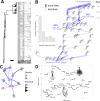Evolutionary accumulation modeling in AMR: machine learning to infer and predict evolutionary dynamics of multi-drug resistance
- PMID: 40396716
- PMCID: PMC12153324
- DOI: 10.1128/mbio.00488-25
Evolutionary accumulation modeling in AMR: machine learning to infer and predict evolutionary dynamics of multi-drug resistance
Abstract
Can we understand and predict the evolutionary pathways by which bacteria acquire multi-drug resistance (MDR)? These questions have substantial potential impact in basic biology and in applied approaches to address the global health challenge of antimicrobial resistance (AMR). In this minireview, we discuss how a class of machine-learning approaches called evolutionary accumulation modeling (EvAM) may help reveal these dynamics using genetic and/or phenotypic AMR data sets, without requiring longitudinal sampling. These approaches are well-established in cancer progression and evolutionary biology but currently less used in AMR research. We discuss how EvAM can learn the evolutionary pathways by which drug resistances and other AMR features (for example, mutations driving these resistances) are acquired as pathogens evolve, predict next evolutionary steps, identify influences between AMR features, and explore differences in MDR evolution between regions, demographics, and more. We demonstrate a case study from the literature on MDR evolution in Mycobacterium tuberculosis and discuss the strengths and weaknesses of these approaches, providing links to some approaches for implementation.
Keywords: AMR; bioinformatics; drug resistance evolution; genome analysis; machine learning; multidrug resistance.
Conflict of interest statement
The authors declare no conflict of interest.
Figures

Similar articles
-
Genetic factors associated with acquired phenotypic drug resistance and its compensatory evolution during tuberculosis treatment.Clin Microbiol Infect. 2024 May;30(5):637-645. doi: 10.1016/j.cmi.2024.01.016. Epub 2024 Jan 28. Clin Microbiol Infect. 2024. PMID: 38286176
-
Genome Informatics and Machine Learning-Based Identification of Antimicrobial Resistance-Encoding Features and Virulence Attributes in Escherichia coli Genomes Representing Globally Prevalent Lineages, Including High-Risk Clonal Complexes.mBio. 2021 Feb 22;13(1):e0379621. doi: 10.1128/mbio.03796-21. Epub 2022 Feb 15. mBio. 2021. PMID: 35164570 Free PMC article.
-
Resistome phylodynamics of multidrug-resistant Shigella isolated from diarrheal patients.Microbiol Spectr. 2025 Jan 7;13(1):e0163524. doi: 10.1128/spectrum.01635-24. Epub 2024 Nov 29. Microbiol Spectr. 2025. PMID: 39612215 Free PMC article.
-
Machine learning: novel bioinformatics approaches for combating antimicrobial resistance.Curr Opin Infect Dis. 2017 Dec;30(6):511-517. doi: 10.1097/QCO.0000000000000406. Curr Opin Infect Dis. 2017. PMID: 28914640 Review.
-
Ecological and evolutionary mechanisms driving within-patient emergence of antimicrobial resistance.Nat Rev Microbiol. 2024 Oct;22(10):650-665. doi: 10.1038/s41579-024-01041-1. Epub 2024 Apr 30. Nat Rev Microbiol. 2024. PMID: 38689039 Review.
References
-
- Naghavi M, Vollset SE, Ikuta KS, Swetschinski LR, Gray AP, Wool EE, Robles Aguilar G, Mestrovic T, Smith G, Han C, et al. 2024. Global burden of bacterial antimicrobial resistance 1990–2021: a systematic analysis with forecasts to 2050. The Lancet 404:1199–1226. doi: 10.1016/S0140-6736(24)01867-1 - DOI - PMC - PubMed
-
- Roberts RR, Hota B, Ahmad I, Scott RD II, Foster SD, Abbasi F, Schabowski S, Kampe LM, Ciavarella GG, Supino M, Naples J, Cordell R, Levy SB, Weinstein RA. 2009. Hospital and societal costs of antimicrobial-resistant infections in a Chicago teaching hospital: implications for antibiotic stewardship. Clin Infect Dis 49:1175–1184. doi: 10.1086/605630 - DOI - PubMed
Publication types
MeSH terms
Substances
Grants and funding
LinkOut - more resources
Full Text Sources
Medical

